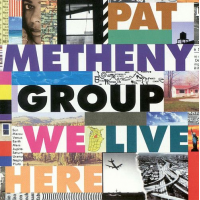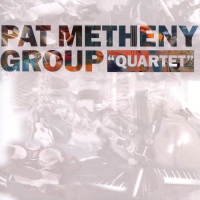Home » Jazz Articles » Multiple Reviews » Pat Metheny Group Reissues: We Live Here & Quartet
Pat Metheny Group Reissues: We Live Here & Quartet
More composition-oriented than Metheny's other projects, the Pat Metheny Group has at various times been accused of being "too smooth," and the groove-centric We Live Here goes a considerable distance to supporting that accusation. But writing We Live Here off as smooth jazz is to ignore one of the Pat Metheny Group's most compelling characteristics—an ability to create music that is eminently accessible but reveals considerable depth when examined more closely. Quartet, on the other hand, finds the group—this time pared down to its core constituents of the time—an altogether more risky affair, the release that's considered to be the most out-of-place disc in the group's nearly thirty-year recording history.
Taken together the two discs provide as broad a cross-section of what the group can be about as one can find, and their return to availability is good news for those who missed out on the discs the first time around.
 Pat Metheny Group
Pat Metheny GroupWe Live Here
Nonesuch Records
2006 (1994)
Returning to the dual-vocal septet line-up of Still Life (Talking) (released in 1987; reissued this year by Nonesuch) with percussionist Luis Conte replacing Armando Marçal, We Live Here's use of programmed rhythm loops and easy-on-the-ears grooves could be considered a concerted commercial attempt by Metheny to expand his already substantial audience. But it also represented its own kind of risk.
Metheny Group fans are typically drawn to the strong sense of melody that's defined the majority of Metheny's writing—alone and with constant collaborator and Metheny Group keyboardist since inception, Lyle Mays. But the opening one-two-three punch of "Here to Stay," "And Then I Knew" and "The Girls Next Door," threatens, at least on the surface, to cross the fine line that Metheny and Mays sometimes straddle between music of depth and substance and mere ear candy.
Many longtime Metheny fans feared that he'd gone too far. But while the album's production values are as close to pop as anything Metheny has ever done, the strength and commitment of the playing elevates the music beyond simple confection. And while much of the music lacks, for example, the tricky time signatures that are oftentimes part of the Metheny/Mays writing approach, there's far more here than immediately meets the ear.
The majority of the songs on the album reflect an interest in soul and R&B that, given Metheny's already broad purview, should come as no surprise. But while the soft ballad "Something To Remind You" bears the ear-marks of groups like Earth Wind & Fire with its clear verse- chorus form, it's still undeniably filtered through Metheny and Mays' own musical sensibilities. The verse is longer than most pop tunes would allow, and while it certainly sounds effortless, its changes are anything but.
Similarly, the more insistent and up-tempo "Red Sky" possesses a singable chorus featuring the lyricless vocals of David Blamires and Mark Ledford (who, sadly, passed away in 2004). But the changes of its equally lengthy verse would again challenge most players. Just because something sounds this easy doesn't mean it is easy and, in some ways, We Live Here could be considered the Pat Metheny Group's most subversive record.
Despite the album's glossy veneer, there are tracks that—despite groove being an essential component—are anything but smooth. The tribal rhythm of the title track is a logical expansion of ideas first explored on "Barcarole," the opening track on Offramp (ECM, 1981). "Episode D'Azur," sporting a knottier theme as well as shifting bar lines that are more in character, doesn't exactly swing but it comes closer to what Metheny Group naysayers consider to be "real" jazz, despite Mays' layering of string washes and signature synthesizer tone. And the album closer, "Stranger in Town," is a more pedal-to-the-metal burner than anything else found on the record, featuring some of Metheny's most lithe playing—especially during the brief middle section that's more-or-less an interactive trio spot for Metheny, drummer Paul Wertico and Conte.
One of the biggest criticisms of the Pat Metheny Group is that, as it has evolved over the past three decades, it's become less and less about the risk that many feel to be a defining characteristic in jazz. And it's true that there's a significant distance between albums like We Live Here and Metheny's collaboration with free jazz legend Ornette Coleman on Song X (released 1985; reissued by Nonesuch in 2005).
But the finely-detailed, through-composed approach of the Pat Metheny Group on We Live Here and earlier records has been at least partially responsible for a paradigm shift allowing jazz artists to explore more complex ideas while, at the same time, remaining completely accessible—not to mention incorporating contemporary production values in ways that need not be inherently paradoxical or antithetical to the spirit of jazz. And while We Live Here was met with a certain amount of surprise and disappointment on original release, even from longtime Metheny Group fans, it's weathered the test of time extremely well. Taken in context of the group's overall body of work, it is ultimately another signpost along its long and varied journey.
 Pat Metheny Group
Pat Metheny GroupQuartet
Nonesuch Records
2006 (1996)
The most under-composed and open-ended record of the Pat Metheny Group discography, this relatively lickety-split recording has been considered by cynics to be nothing more than a contractual obligation record—the last recording Metheny made for Geffen before moving to Warner Bros. and releasing Imaginary Day (Warner Bros., 1997). It's an album that, along with the recent The Way Up, could be considered one of the group's most revolutionary records to date.
Dismissing Quartet as nothing more than a contractual obligation record is as unfair as considering We Live Here to be nothing more than smooth jazz. Coming off a world tour to promote We Live Here, Metheny took the core quartet— himself, Mays, bassist Steve Rodby and Wertico—into the studio to record what is undeniably the most oblique and free record the group has ever made. With the exception of the title track from Offramp (ECM, 1981) and "Scrap Metal"—a live staple that's never found its way onto a Metheny Group studio record—Quartet is about as loose and under-produced as it gets.
That's not to say there aren't glimmers of Metheny's rich melodicism. The brief rubato "Introduction" and poignant waltz "When We Were Free" are as compelling as anything he's written. But given the more produced nature of Pat Metheny Group, these tunes and others including the dark ballad "Seven Days" and the Midwestern-inflected "Sometimes I See," feel as though they'd be more at home on one of his non- Pat Metheny Group records. Still, it's a testimonial to his core quartet that they feel completely at home in this less-confined context.
Wertico is a player whose reach extends beyond the Pat Metheny Group's more listener-friendly aesthetic, as has already been proven on albums including Sign of Four (Knitting Factory, 1996)—with Metheny, percussionist Gregg Bendian and the late free jazz guitarist Derek Bailey—and Bang! (Truemedia Jazzworks, 1996)—a challenging set of percussion duets, again with Bendian. Equally, Mays has proven greater breadth and open-mindedness on his own recordings, in particular Solo: Improvisations For Expanded Piano (Warner Bros., 2000).
But perhaps the biggest surprise is Rodby. He rarely solos, but he's been a remarkably flexible anchor for Metheny since joining the band in 1980—the kind of dependable player who is rarely in the spotlight, but has the remarkably consistent ability to find the right note at just the right time. On Quartet he gets the opportunity to work on a larger playing field, from the understated power of "Take Me There," where his resonant bass works in perfect consonance with Wertico to keep things bubbling underneath Metheny's rapid-fire exchange, to the brooding "Oceana," where he gets a rare opportunity to be the front-man, eloquently stating its simple theme.
Elsewhere there are pieces fashioned from free improvisations and the barest of sketches, like "Montevideo," which begins with a sound more akin to something one would hear on an Evan Parker or Derek Bailey record, but gradually morphs into a groove-based jam and, ultimately, a brief but change-based solo spot for Mays—and all this in just under three minutes.
"Dismantling Utopia" is an equally episodic piece that brings together a series of seemingly disparate ideas. Beginning with a curious repeated figure from Metheny on a number of layered guitars, and an abstract theme from Mays, a curiously cacophonic solo from Wertico leads into a more settled but still abstruse melody from Metheny, before breaking down into total free play that, at times, feels more in keeping with contemporary classical music. It's likely that these two collage-like pieces are the product of judicious editing, but the end results feel as though they were intended to be this way from the very beginning.
For those who have preconceived and narrow ideas about what the Pat Metheny Group is about, a good suggestion would be to take some time to revisit the path from Pat Metheny Group (ECM, 1978) to The Way Up (Nonesuch, 2005). The fact is that, while there's always been a strong compositional emphasis, the group's evolution has seen it experiment with a diversity of forms.
We Live Here and Quartet are just two of them but, in their own way, their stylistic breadth makes a strong case for the Pat Metheny Group as jazz's most successful group to combine accessibility with a daring sense of adventure. The clearly voracious musical appetites of original members Metheny and Mays—along with longstanding member Rodby and anyone else who happens to be in a particular incarnation of the group at any given time—have resulted in a body of work where few, if any, boundaries exist, while at the same time forging a unique identity that's instantly recognizable from the first note.
Personnel and Track Listings
We Live Here
Personnel: Pat Metheny: guitars, guitar synth; Lyle Mays: piano, keyboards; Steve Rodby: acoustic & electric bass; Paul Wertico: drums; Luis Conte: percussion; David Blamires: vocals; Mark Ledford: vocals, whistling, flugelhorn.
Tracks: Here To Stay; And Then I Knew; The Girls Next Door; To The End Of The World; We Live Here; Episode D'Azur; Something To Remind You; Red Sky; Stranger In Town.
Quartet
Personnel: Pat Metheny: acoustic and electric guitars, 12-string guitar, 42-string pikasso guitar; e-bows and slide, soprano guitars, fretless guitar, guitar synth; Lyle Mays: piano, non-tuned spinet piano, celeste, pedal harmonium, autoharps, electric piano, clavinet; Steve Rodby: acoustic bass, piccolo bass; Paul Wertico: drums, percussion.
Tracks: Introduction; When We Were Free; Montevideo; Take Me There; Seven Days; Oceana; Dismantling Utopia; Double Blind; Second Thought; Mojave; Badland; Glacier; Language Of Time; Sometimes I See; As I Am.
< Previous
Blue
Next >
Zimbabwe: Roots And Legends
Comments
Tags
For the Love of Jazz
 All About Jazz has been a pillar of jazz since 1995, championing it as an art form and, more importantly, supporting the musicians who create it. Our enduring commitment has made "AAJ" one of the most culturally important websites of its kind, read by hundreds of thousands of fans, musicians and industry figures every month.
All About Jazz has been a pillar of jazz since 1995, championing it as an art form and, more importantly, supporting the musicians who create it. Our enduring commitment has made "AAJ" one of the most culturally important websites of its kind, read by hundreds of thousands of fans, musicians and industry figures every month.


















